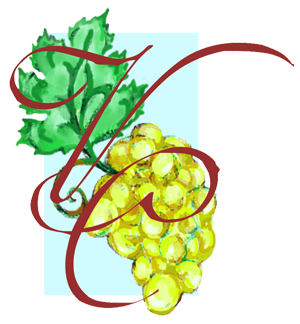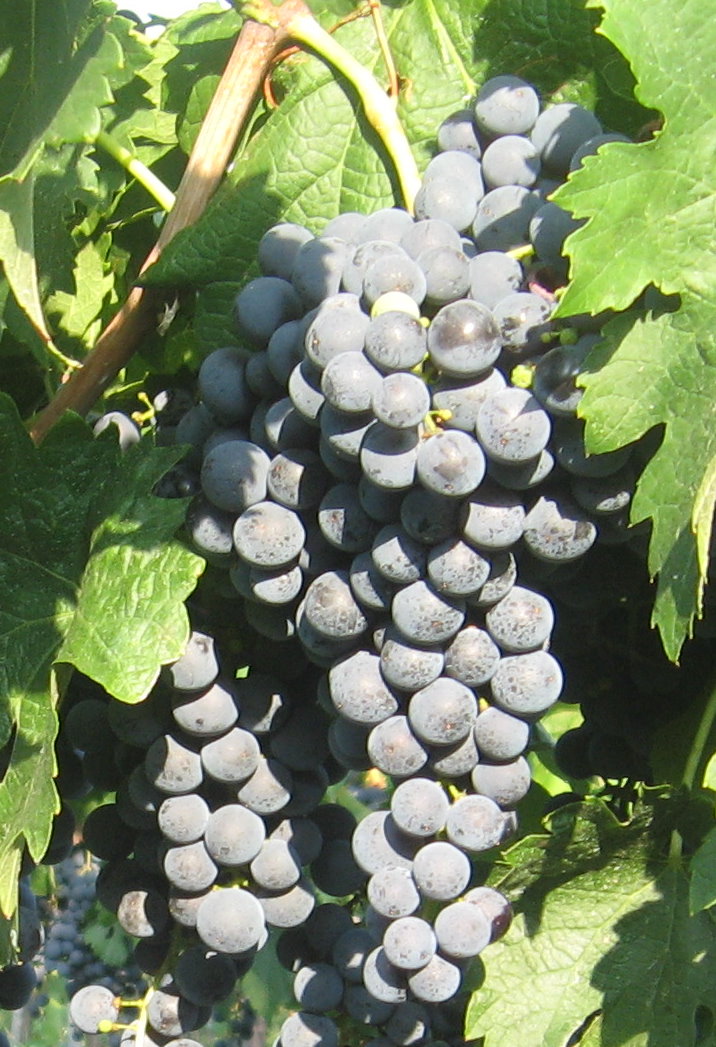Merlot is a dark blue-colored wine grape variety, that is used as both a blending grape and for varietal wines. The name Merlot is thought to be a diminutive of merle, the French name for the blackbird, probably a reference to the color of the grape. Its softness and "fleshiness", combined with its earlier ripening, makes Merlot a popular grape for blending with the sterner, later-ripening Cabernet Sauvignon, which tends to be higher in tannin.[1]
Along with Cabernet Sauvignon, Cabernet Franc, Malbec and Petit Verdot, Merlot is one of the primary grapes used in Bordeaux wine, and it is the most widely planted grape in the Bordeaux wine regions. Merlot is also one of the most popular red wine varietals in many markets.[2] This flexibility has helped to make it one of the world's most planted grape varieties. As of 2004, Merlot was estimated to be the third most grown variety at 260,000 hectares (640,000 acres) globally, with an increasing trend.[3] This puts Merlot just behind Cabernet Sauvignon's 262,000 hectares (650,000 acres).
While Merlot is made across the globe, there tends to be two main styles. The "International style" favored by many New World wine regions tends to emphasize late harvesting to gain physiological ripeness and produce inky, purple colored wines that are full in body with high alcohol and lush, velvety tannins with intense, plum and blackberry fruit. While this international style is practiced by many Bordeaux wine producers, the traditional "Bordeaux style" of Merlot involves harvesting Merlot earlier to maintain acidity and producing more medium-bodied wines with moderate alcohol levels that have fresh, red fruit flavors (raspberries, strawberries) and potentially leafy, vegetal notes.[4]
Merlot grapes are identified by their loose bunches of large berries. The color has less of a blue/black hue than Cabernet Sauvignon grapes and with a thinner skin and fewer tannins per unit volume. It normally ripens up to two weeks earlier than Cabernet Sauvignon. Also compared to Cabernet, Merlot grapes tend to have a higher sugar content and lower malic acid.[6] Ampelographer J.M. Boursiquot has noted that Merlot has seemed to inherit some of the best characteristics from its parent varieties—its fertility and easy ripening ability from Magdeleine Noire des Charentes and its color, tannin and flavor phenolic potential from Cabernet Franc.[1]
Merlot thrives in cold soil, particularly ferrous clay. The vine tends to bud early which gives it some risk to cold frost and its thinner skin increases its susceptibility to the viticultural hazard of Botrytis bunch rot. If bad weather occurs during flowering, the Merlot vine is prone to develop coulure.[9] The vine can also be susceptible to downy mildew (though it has better resistance to powdery mildew than other Bordeaux varieties) and to infection by leafhopper insect varieties.[1]
Water stress is important to the vine with it thriving in well drained soil more so than at base of a slope. Pruning is a major component to the quality of the wine that is produced with some producing believing it is best to prune the vine "short" (cutting back to only a few buds). Wine consultant Michel Rolland is a major proponent of reducing the yields of Merlot grapes to improve quality.[5] The age of the vine is also important, with older vines contributing character to the resulting wine.[6]
A characteristic of the Merlot grape is the propensity to quickly overripen once it hits its initial ripeness level, sometimes in a matter of a few days. There are two schools of thought on the right time to harvest Merlot. The wine makers of Château Pétrus favor early picking to best maintain the wine's acidity and finesse as well as its potential for aging. Others, such as Rolland, favor late picking and the added fruit body that comes with a little bit of over-ripeness.[5]




